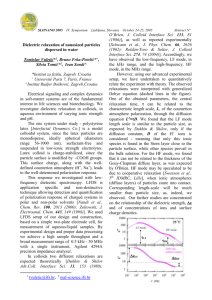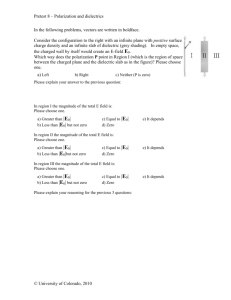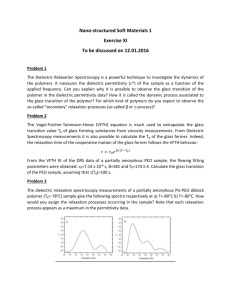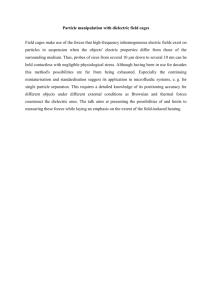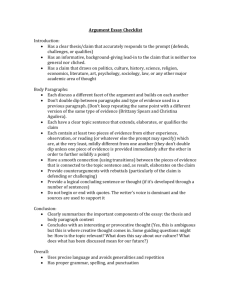polarization constant
advertisement
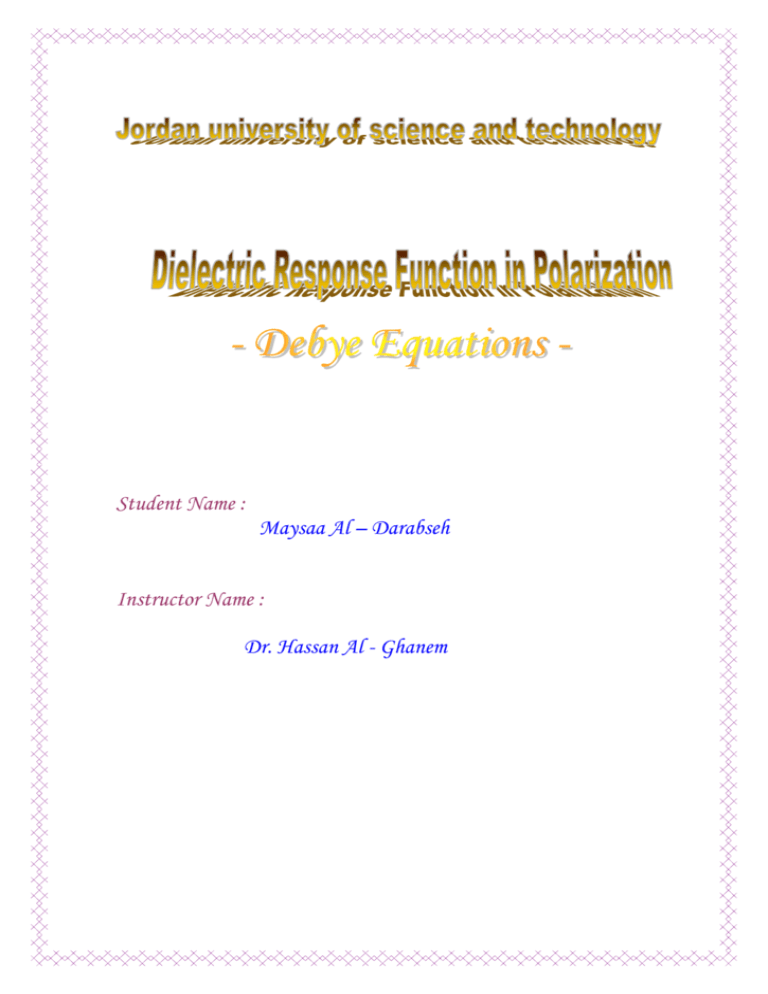
Student Name : Maysaa Al – Darabseh Instructor Name : Dr. Hassan Al - Ghanem - Abstract When a dielectric material is placed in an external electric field, it will be polarized with time, the polarization goes through a relaxation process by making successive collisions inside the material, suffering energy loss in these processes. These processes of energy loss extends over a wide range of frequencies, covering all kinds of polarizations, electronic, ionic and orientational. It is the purpose of this project to study the relaxation processes due to orientation in the dipole moments, to derive the components of the dielectric constant and their dependence on frequency. We will check also the validity of Debye theory for diluted liquids. - Introduction The electric properties of dielectric materials are usually described in terms of the dielectric constant .For most materials this quantity is independent of the strength of the electric field over a wide range of it, but in the case of alternating fields it depends on the frequency . It also depends on other parameters such as the temperature. When an ideal dielectric body is exposed to an electric field there exist only bound charges that can be displaced from their equilibrium positions. This phenomenon is called displacement polarization. In molecular dielectrics, bound charges form permanent dipoles. The molecular dipoles can only be rotated by an electric field. Usually, their dipole moments are randomly oriented. In an external field the permanent dipoles rotate with the electric field direction and this process is called orientational polarization. The most important phenomenon in dielectric materials when exposed to an external alternating electric field is the relaxation in these dipoles, which is the subject of our project. 2 - Theory - When we apply an external static field to a dielectric ® D material ( = 0 ) the electric displacement written as: ® ® Ds = es E -----[1] ® And, the electric displacement D equal: ® ® ® D = e0 E + P ® ® -----[2] ® e0 er E = e0 E + P Then, Where, er is the relative dielectric constant defined as e\ e0 . From these two equations the polarization is given by: ® HL HL H L ® P = e0 er - 1 E -----[3] - In static field case equation[3] becomes: ® ® P s = e0 es - 1 E And we can write Ps as: H L Ps = P¥ + Ps Where, dip -----[4] -----[5] P¥ :The part due to the polarizability of the particles. Ps dip : The part of Ps due to permanent dipoles. HL From Eq.[4] we can write: ® ® P ¥ = e0 e¥ - 1 E 3 -----[6] The time needed by dipoles to reach the equilibrium distribution -6 - 13 is in the range ( 10 to 10 s) .[due to static external electric field]. H L - During this interval of time : [1]- Ps dip built up as shown in Fig.[1]. [2]- P increased from zero to Ps . ( The time needed to reach P¥ will be neglect ) Fig.[1]- The polarizability as a function of time. H L HL where, the polarization is given by : P E = P 0 L E, T where, L is Langevin function. 4 Now, after an interval of time ( t ) : P t = P ¥ + P dip -----[7] Then, due to relaxation mechanism, the rate of which dipole build up in the material is given by: dP dip 1 = dt t @ HL D Ps dip - P dip -----[8] Where, : The relaxation time of the mechanism. - When the constant electric field is suddenly switched off, then : H L Ps dip = 0 Then, Eq.[8] becomes: dP dip 1 = P dt t dip HLHL à à H L [ Pdip - Integrating Eq.[9] we get : t 0 then, -----[9] dP dip 1 = P dip t P dip = P s 5 dip e - t t t =0 = Ps dip ] t ât 0 -----[10] ----------------------------------------------------------------------- H L H L HLHL H L HL BHL F - For alternating field at time t : ® E w = E0 ei w t From Eq's.[4],[5]and[6] we get : Ps dip = Ps - P¥ ® ® = e0 es - 1 E - e0 e¥ - 1 E Then, ® Ps Then , From Eq.[8] dip = e0 es - e¥ E -----[11] ® dP dip 1 = e0 es - e¥ E - P dip dt t then the solution of this equation give: P dip = C e - t t + HL e0 es - e¥ ® E 1 + iwt -----[12] - t t The term C e in Eq.[12] will be neglect because it's decreases to small value after some time.(transient term). Then, the steady state solution, P dip = HL e0 es - e¥ E0 ei wt 1 + iwt 6 -----[13] We know that: HL HL B HLHLF A HL E A E P t = P ¥ + P dip = e0 e¥ - 1 E0 ei w t + Then, e0 es - e¥ 1 + iwt es - e¥ 1 + iwt P t = e0 e¥ - 1 + E0 ei w t E0 ei w t -----[14] Using Eq.[2] and Eq.[14]: ® ® ® D = e0 E + P ® = e0 E + e0 e¥ - 1 + This means that: ® D = e0 e¥ + es - e¥ 1 + iwt es - e¥ 1 + iwt E0 ei wt E0 ei wt -----[15] ® ® * From the relation of the complex electric displacement D = e* E and comparing it with Eq.[15] : The complex permitivity is given by : e* = e¥ + es - e¥ 1 + iwt and, e* = e` - i e`` 7 -----[16] From Eq.[16] e* = e¥ + Then, HLHL HL HH L L es - e¥ 1 - iwt 1 + wt 2 e` = e¥ + & e`` = es - e¥ 1 + wt 2 es - e¥ wt 1 + wt 2 -----[17] -----[18] - Eq's[17] and [18] are called Debye equations. We plotted on figures [1, 2 and 3] equations [17] and[18 ]for different relaxation times and for different dielectric strengths. 8 - Results and Conclusions 25 ε8 = 2 εs = 20 20 τ = 10-2 15 έ 10 ε? 5 0 2.5 8 13.5 19 24.5 30 lnω ε8 = 2 25 εs = 20 έ 20 τ = 10-6 15 10 ε? 5 0 4 9 14 19 lnω 24 29 25 ε8 = 2 20 εs = 20 έ τ = 10-4 15 10 ε? 5 0 4 9 14 19 24 29 lnω Fig.[2] variation of the real and imaginary parts of dielectric constant,έ andε˝ with frequency . ( For different values of relaxation time ) 9 25 έ έ 20 τ = 10-6 έ 15 τ = 10-4 τ = 10-2 10 ε? ε? ε? 5 0 3 8 13 18 Fig.[3] variation of the real and imaginary parts of dielectric constant, έ and ε˝ with frequency . ( For different values of relaxation time ) - In the figure we showed that when the relaxation time is large the variation of the real and imaginary parts of dielectric constant, έ and ε˝ with frequency is very fast, although the strength of the dielectric material remains constant. - The difference between εs and ε∞ gives the polarizibilitystrength- of dielectric material. 10 ε8 = 1 30 έ 25 εs = 25 τ = 10-6 20 15 ε? 10 5 0 4 9 14 19 24 29 lnω ε8 = 2 25 εs = 10 20 τ = 10-6 15 έ 10 5 ε? 0 4 9 14 19 24 29 lnω ε8 = 2 25 εs = 20 έ 20 τ = 10-6 15 ε? 10 5 0 4 9 14 19 24 29 lnω Fig.[4]- variation of the real and imaginary parts of dielectric constant, έ and ε˝ with frequency . ( For different values of ε∞ and εs with constant relaxation time ) ε˝ ε∞ = 2 εs = 20 έ Fig [5] – The relation ship between the real and imaginary parts of dielectric constant, έ and ε˝ for ε∞ = 2 and εs = 20 . Figure[5] shows the relation between έ and ε˝ which is called “ Niquist plots” or Cole-Cole plots. It gives a semi circle with its center on the real axes of έ. 20 ε˝ 17.5 15 12.5 ε∞ = 2 εs = 20 10 7.5 5 ε∞ = 2 εs = 10 2.5 2.5 5 7.5 10 12.5 15 17.5 έ 20 Fig[6]- The dependence of Niquist plots on the dielectric strength of the material for an ideal diluted polar system. Generally, we can apply Debye theory in polarization in a general way by considering a series of relaxation processes. then, we can write Equ.[16] as : e* = e¥ + HL es - e¥ 1 + iwt n -----[19] where, the variable n equals one for ideal case which satisfies Debye’s formula. but, if it deviates from the ideal case , Equ.[19] can be written as: HL es - e¥ 1 + wt n in e* = e¥ + ip but, i is a phaser (i = e 2 ) then, in = e this gives: ip n 2 np np + i sin 2 2 = cos HLH L L HLHH L HL H L HLH L HL e* = e¥ + 1 + wt n es - e¥ cos n2p + i sin np 2 -----[20] Separation of the real and imaginary parts leads to : ` e - e¥ = es - e¥ and `` 1 + 2 wt wt e = es - e¥ 1 + 2 wt ` n 1 + wt `` n n n cos n cos n sin n sin n p 2 p 2 p 2 + wt 2n -----[21] p 2 + wt 2n -----[22] The distribution of the e and e which is described in Equ’s [21] and [22] are showed in Fig.[7]for the case of n = 0.8. ε˝ ε∞ = 2 εs = 20 ideal έ Fig [7] – The relation between έ and ε˝ displaying the difference between the ideal Debye model and the deviation from simple theory. From Fig.[7] we can see clearly that the center of a semi circle of the Cole-Cole plots when we consider a series of relaxation processes is not on the real axes of έ .but, it deviates by a small angle θ from the έ axes which is called the dip angle. The dip angle θ equal some parameter h multiplied with π/2. where, the parameter h equal zero when the dielectric has only one relaxation time .but, for the case of dielectric which has a series of relaxation times the parameter h is between zero and one. Then ,the dip angle can be written as: q= HL p p h= 1- n 2 2 -----[23] From Fig.[7], the center of the deviation semi circle is at the point ( 11 , -2.9 ).then, we can get the dip angle from e`` 2.9 = = 0.322 e` 9 q = tan- 1 0.322 = 17.86 0 q = 0.0992 p rad tan q = then, from Equ.[23] we can find that the value of n is 0.8. where this value agrees with our assumption. - References : - C.J.F.Bottchetr,” Theory of electric polarization”. - H.Frohlich,”Theory of dielectrics”. second edition.1958. - J.R.Hook,”Solid state physics”. Second edition.1991.
